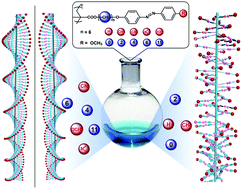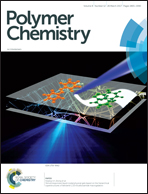Induction of supramolecular chirality by chiral solvation in achiral Azo polymers with different spacer lengths and push–pull electronic substituents: where will chiral induction appear?†
Abstract
Induction of supramolecular chirality from achiral compounds has been exploited in small molecules, oligomers and polymer systems. However, the relationship between the structure of building blocks and induction of supramolecular chirality is often poorly understood. Herein, we designed and synthesized a series of azobenzene (Azo) side-chain polymers with different spacer lengths (n is the number of methylene units in the spacer, n = 0, 2, 4, 6, 11) and push–pull electronic substituents (R is the terminal group of the Azo unit, R = OCH3, CH3, CN, N(CH3)2, H) by reversible addition–fragmentation chain transfer polymerization. The structure of achiral side-chain Azo polymers with different push–pull groups and spacer lengths had strong effects on supramolecular chirality induced by chiral limonene. No apparent chiral amplification phenomena were observed for all Azo polymer systems. These aggregates of several Azo polymers in dichloroethane/limonene mixed solvent were characterized by circular dichroism (CD) and UV-vis spectroscopy, demonstrating the successful chirality transfer from limonene molecules to PM4Az, PM6Az, PM11Az, PM6CN and PM6N. However, when spacer lengths were shorter (PM0Az and PM2Az), the supramolecular chirality arising from well-assembled achiral side-chain Azo units was not observed and the polymer aggregates had no CD signal. Meanwhile, the CD signal was absent for Azo polymers containing CH3 or H terminal groups. The polymers with longer spacer lengths (PM11Az) showed better reversibility of the chiral–achiral switch by trans–cis photoisomerization and cis–trans thermal-isomerization processes compared to PM4Az, PM6Az and PM6CN. Intriguingly, the chiral aggregate of PM6N showed good stability of supramolecular chirality under 405 nm light exposure over 40 min. These findings will not only provide significant insight into the structure–property relationship for inducing supramolecular chirality from achiral polymers, but also give cues for design of stabilized chiroptical materials.



 Please wait while we load your content...
Please wait while we load your content...